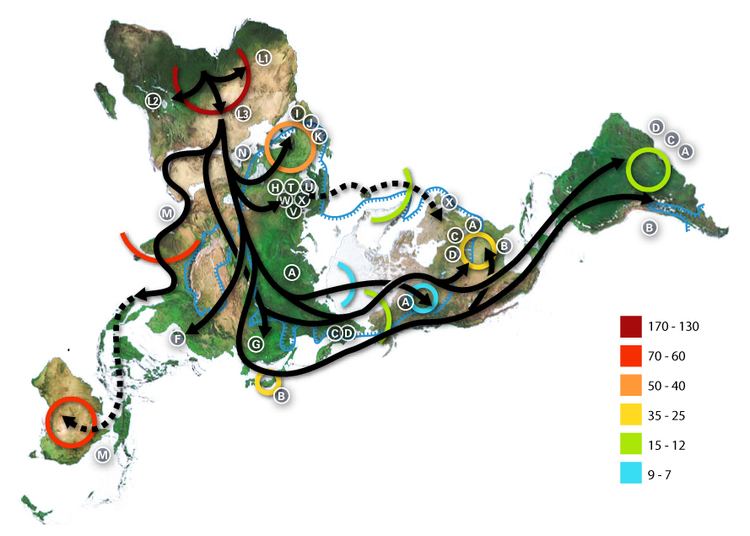Defining mutations 769, 1018, 16311 | Ancestor L3'4 | |
 | ||
Possible time of origin 80,000-104,000 YBP or 60,000-70,000 YBP Descendants L3a, L3b'f, L3c'd'j, L3e'i'k'x, L3h, M, N | ||
Haplogroup L3 is a human mitochondrial DNA (mtDNA) haplogroup. The clade has played a pivotal role in the prehistory of the human species. It represents the most common parent maternal lineage of all people outside of Africa, and for many individuals within the continent as well.
Contents
Origin
The exact place of origin of haplogroup L3 is uncertain. According to the Recent African origin of modern humans (Out-of-Africa) theory, the clade is believed to have arisen in Africa and dispersed from East Africa between 84,000 and 104,000 years ago. An analysis of 369 complete African L3 sequences placed the maximal date of the clade's expansion at ∼70 ka. This virtually rules out a successful exit out of Africa before 74 ka, the date of the Toba volcanic super-eruption in Sumatra. The Time to Most Recent Common Ancestor for the L3 lineage has also recently been estimated to be between 58,900 and 70,200 years ago.
Distribution
L3 is common in Northeast Africa, in contrast to others parts of Africa where the haplogroups L1 and L2 represent two thirds of mtDNAs. L3 sublineages are also frequent in the Arabian peninsula.
L3 is sub-divided into several clades, two of which spawned the macro-haplogroups M and N that are today carried by most people outside of Africa. There is at least one relatively deep non-M, non-N clade of L3 outside Africa, L3f1b6, found at 1% in Asturias Spain, which diverged from African L3 lineages at least 10,000 years ago.
According to Maca-Meyer et al. (2001), "L3 is more related to Eurasian haplogroups than to the most divergent African clusters L1 and L2". L3 is the haplogroup from which all modern humans outside of Africa derive.
Basal haplogroup L3* is found among Nubians (13.8%), as well as Socotri (4.3%).
Subclade distribution
Undifferentiated L3 is widely distributed, particularly in the Chad Basin. It is also found among Egyptians inhabiting El-Hayez oasis (11.4%).
Tree
This phylogenetic tree of haplogroup L3 subclades is based on the paper by Mannis van Oven and Manfred Kayser Updated comprehensive phylogenetic tree of global human mitochondrial DNA variation and subsequent published research.
Most Recent Common Ancestor (MRCA)
